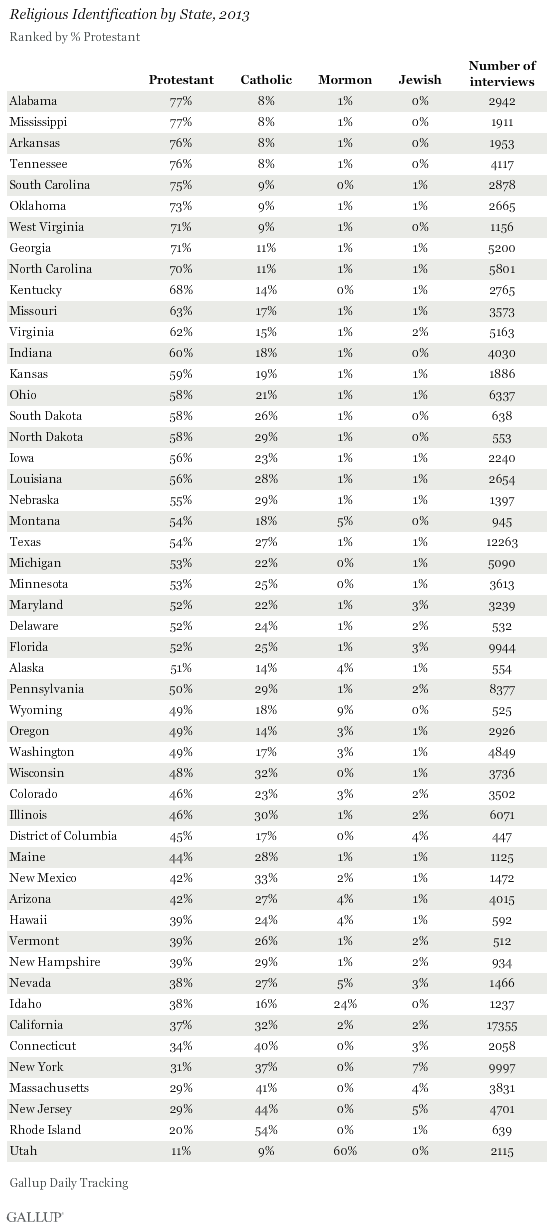PRINCETON, NJ -- Fifty-one percent of Americans identified as Protestant or other non-Catholic Christian in 2013, making this by far the largest major religious grouping in the country. All 10 of the most Protestant states are located in the South. Nine of these states are at least 70% Protestant, including the two most highly Protestant states, Mississippi and Alabama, each with a 77% Protestant population.
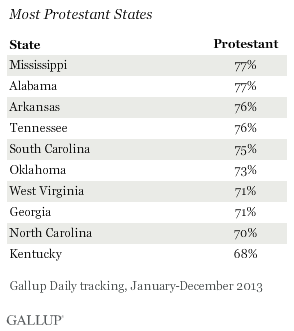
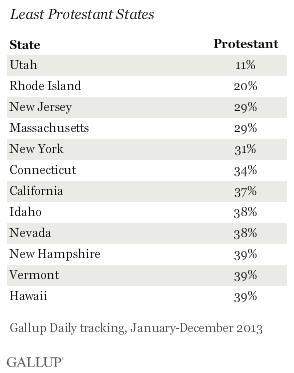
These state-level findings come from a nationally representative sample of more than 178,000 U.S. adults interviewed as part of Gallup Daily tracking from January through December 2013. Each state's results are based on more than 500 interviews, with 447 taking place in the District of Columbia. Complete results and sample sizes are on page 2.
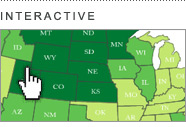 |
| Explore complete state data > |
Gallup measures Americans' religious identity by asking, "What is your religious preference -- are you Protestant, Roman Catholic, Mormon, Jewish, Muslim, another religion, or no religion?" If Americans name another religion, they are asked: "Would that be a Christian religion or is it not a Christian religion?"
The Protestant percentage is based on those who say they are Protestant or who identify with "another religion" and, upon probing, indicate that it is a Christian faith other than Catholic or Mormon. Americans' recognition of the "Protestant" label has declined in recent years, but the term provides a useful way of describing Americans who are non-Catholic, non-Mormon Christians. The 2013 percentage of the population identifying as Protestant (51%) is down slightly from 54% in 2008.
The least Protestant state is heavily Mormon Utah, which is only 11% Protestant. Other states with low representations of Protestants are in New England and the Middle Atlantic, along with the Western states of California, Idaho, Nevada, and Hawaii.
Rhode Island Has Highest Percentage of Catholics
More than half of Rhode Island's population (54%) is Catholic, making it the most Catholic state in the union, and the only state in which the Catholic population is at least twice the national average (24%). The next four most Catholic states are also on the East Coast, including New Jersey, Massachusetts, Connecticut, and New York. The least Catholic states are generally the highly Protestant Southern states, along with Utah.

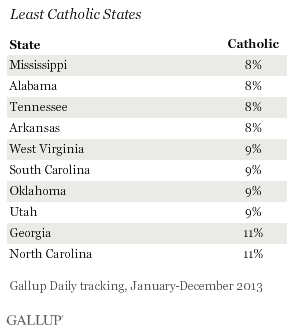
The 24% of Americans identifying themselves as Catholic in 2013 conforms to the generally stable percentage of the population identifying themselves this way since 2008.
In addition to the high representation of Catholics on the East Coast (including the top five states plus New Hampshire), above-average proportions of Catholics are found in nearby Pennsylvania, four Midwestern states -- Wisconsin, Illinois, North Dakota, and Nebraska -- and two states with high Hispanic populations, New Mexico and California.
On the other hand, nine of the 10 least Catholic states are in the South, with the bottom four -- Mississippi, Alabama, Tennessee, and Arkansas -- all having just 8% Catholic populations. Of these 10 states, only Utah is not in the South, reflecting its predominantly Mormon population.
Mormons and Jews
Mormons represent about 2% of the U.S. adult population, but are concentrated in a small number of states. Utah, at 60% Mormon, is followed by Idaho (24%) and Wyoming (9%). All other states have 5% or fewer Mormons, and 11 states have so few Mormons that their percentage in Gallup's 2013 interviewing rounds to zero.
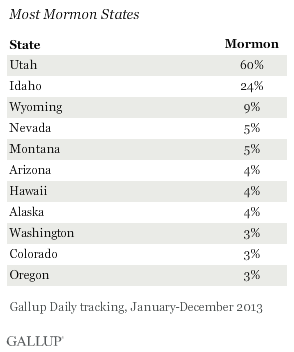
About 2% of the U.S. population identifies itself as Jewish, but unlike Mormons, Jews are much more evenly distributed across the states. The highest Jewish concentration of any state -- in New York -- is just 7%. Other states with slightly higher-than-average Jewish populations include New Jersey (5%) and Massachusetts (4%), in addition to the District of Columbia (4%).

Bottom Line
The distribution across the states of the two large religious classifications of Americans has remained generally stable over the past five years, with the highest proportions of Protestants in the South, while Catholics are more highly concentrated in the Middle Atlantic and New England regions, along with several states with higher Hispanic populations and a few states in the Midwest. Two other religious groups that are much smaller constitute about 2% of the population each, with Mormons concentrated in Utah and Idaho, and Jewish Americans most likely to be found in several Middle Atlantic and New England states, plus the District of Columbia. A large group of Americans, about 18% in 2013, have no formal religious identity.
Gallup's "State of the States" series reveals state-by-state differences on political, economic, and well-being measures Gallup tracks each day. New stories based on full-year 2013 data will be released in the coming months.
Survey Methods
Results for this Gallup poll are based on telephone interviews conducted Jan. 2-Dec. 29, 2013, on the Gallup Daily tracking survey, with a random sample of 178,521 adults, aged 18 and older, living in all 50 U.S. states and the District of Columbia.
For results based on the total sample of national adults, the margin of sampling error is ±1 percentage point at the 95% confidence level.
Margins of error for individual states are no greater than ±6 percentage points, and are ±3 percentage points in most states. The margin of error for the District of Columbia is ±6 percentage points.
Interviews are conducted with respondents on landline telephones and cellular phones, with interviews conducted in Spanish for respondents who are primarily Spanish-speaking. Each sample of national adults includes a minimum quota of 50% cellphone respondents and 50% landline respondents, with additional minimum quotas by time zone within region. Landline and cellular telephone numbers are selected using random-digit-dial methods. Landline respondents are chosen at random within each household on the basis of which member had the most recent birthday.
Samples are weighted to correct for unequal selection probability, nonresponse, and double coverage of landline and cell users in the two sampling frames. They are also weighted to match the national demographics of gender, age, race, Hispanic ethnicity, education, region, population density, and phone status (cellphone only/landline only/both, cellphone mostly, and having an unlisted landline number). Demographic weighting targets are based on the most recent Current Population Survey figures for the aged 18 and older U.S. population. Phone status targets are based on the most recent National Health Interview Survey. Population density targets are based on the most recent U.S. census. All reported margins of sampling error include the computed design effects for weighting.
In addition to sampling error, question wording and practical difficulties in conducting surveys can introduce error or bias into the findings of public opinion polls.
For more details on Gallup's polling methodology, visit www.gallup.com.
